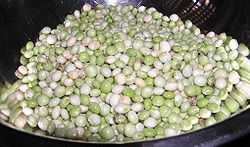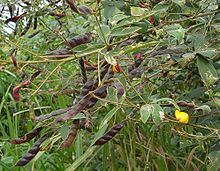| Pigeon pea | |
|---|---|
 | |
| Scientific classification | |
| Kingdom: | Plantae |
| (unranked): | Angiosperms |
| (unranked): | Eudicots |
| (unranked): | Rosids |
| Order: | Fabales |
| Family: | Fabaceae |
| Genus: | Cajanus |
| Species: | C. cajan |
| Binomial name | |
| Cajanus cajan (L.) Millsp. | |
Contents
|
Cultivation
The cultivation of the pigeon pea goes back at least 3000 years. The centre of origin is most likely Asia, from where it traveled to East Africa and by means of the slave trade to the American continent. Today pigeon peas are widely cultivated in all tropical and semi-tropical regions of both the Old and the New World. Pigeon peas can be of a perennial variety, in which the crop can last 3–5 years (although the seed yield drops considerably after the first two years), or an annual variety more suitable for seed production.Pigeon peas are an important legume crop of rainfed agriculture in the semi-arid tropics. The Indian subcontinent, Eastern Africa and Central America, in that order, are the world's three main pigeon pea producing regions. Pigeon peas are cultivated in more than 25 tropical and sub-tropical countries, either as a sole crop or intermixed with cereals such as sorghum (Sorchum bicolor), pearl millet (Pennisetium glaucum), or maize (Zea mays), or with other legumes, such as peanuts (Arachis hypogaea). Being a legume, the pigeon pea enriches soil through symbiotic nitrogen fixation.
The crop is cultivated on marginal land by resource-poor farmers, who commonly grow traditional medium- and long-duration (5–11 months) landraces. Short-duration pigeon peas (3–4 months) suitable for multiple cropping have recently been developed. Traditionally, the use of such input as fertilizers, weeding, irrigation, and pesticides is minimal, so present yield levels are low (average = 700 kg/ha). Greater attention is now being given to managing the crop because it is in high demand at remunerative prices.
Pigeon peas are very drought resistant and can be grown in areas with less than 650 mm annual rainfall.
World production of pigeon peas is estimated at 46,000 km2. About 82% of this is grown in India. These days it is the most essential ingredient of animal feed used in West Africa, most especially in Nigeria where it is also grown.
Uses

Pigeon peas from Trinidad and Tobago
In India, split pigeon peas (toor dal) are one of the most popular pulses, being an important source of protein in a mostly vegetarian diet. In regions where it grows, fresh young pods are eaten as vegetable in dishes such as sambhar.
In Ethiopia, not only the pods but the young shoots and leaves are cooked and eaten.[3]
In some places, such as the Dominican Republic and Hawaii, pigeon peas are grown for canning and consumption. A dish made of rice and green pigeon peas (called "Moro de Guandules") is a traditional food in Dominican Republic. Pigeon peas are also made as a stew, with plantain balls. In Puerto Rico, arroz con gandules is made with rice and pigeon peas and is a typical dish. Trinidad & Tobago has its own variant, called pelau, which includes either beef or chicken, and occasionally pumpkin and pieces of cured pig tail.
In Thailand, pigeon peas are grown as a host for scale insects which produce lac.
Pigeon peas are in some areas an important crop for green manure, providing up to 40 kg nitrogen per hectare. The woody stems of pigeon peas can also be used as firewood, fencing and thatch.



No comments:
Post a Comment